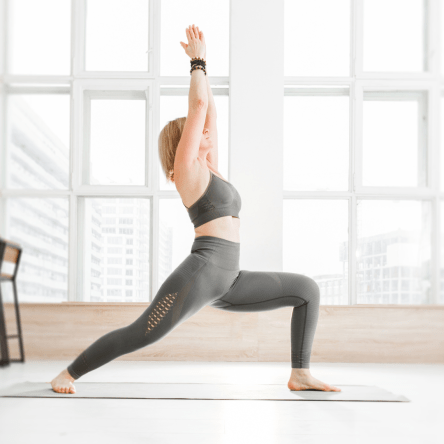A Safe and Effective Path to a Supple Body
For those new to the practice of yoga or anyone who feels inflexible, the journey to achieving greater flexibility may seem daunting. However, here’s a little secret that can transform your practice and help you progress safely and effectively: strength and flexibility go hand in hand. Many believe that flexibility is solely about stretching, but incorporating strength training into your routine can be a game-changer. Not only does it provide a solid foundation for your yoga practice, but it also keeps your body safe while promoting improved flexibility. So, let’s dive into why working on strength is essential in the pursuit of flexibility, especially for those who prefer practicing at home.

Building a Solid Foundation
Strength provides stability and support to your body, preventing injuries and allowing you to explore deeper stretches safely. When your muscles are strong, they act as a protective shield for your joints and ligaments during various yoga poses, minimizing the risk of strains and sprains.
Because your body is always trying to keep you safe your muscles will tighten if your mind thinks you are stretching to far. If your body is strong enough it will allow you to stretch a little further. The body really is an amazing thing.
Strengthening Key Muscle Groups
Certain muscle groups play a crucial role in enhancing flexibility, and strengthening them can yield remarkable results. Targeting muscles such as the core, hamstrings, quadriceps, hip flexors, and back muscles not only aids in proper alignment but also helps release tension that might be inhibiting your range of motion.

Let’s delve deeper into how certain muscle groups play a vital role in enhancing flexibility and how strengthening them can lead to remarkable results in yoga practice:
- Core Muscles: The core muscles are the foundation of stability and support in yoga postures. A strong core helps maintain proper alignment during various poses, reducing the strain on other parts of the body. When the core muscles are weak, practitioners may experience difficulty in balancing poses and find it challenging to achieve deep stretches. By strengthening the core, practitioners can stabilize their movements, allowing for safer and more controlled exploration of flexibility.
- Hamstrings and Quadriceps: The hamstrings (back of the thighs) and quadriceps (front of the thighs) are essential muscle groups in yoga as they are frequently engaged during forward folds, lunges, and standing poses. Tight hamstrings can limit the ability to fold forward, and tight quadriceps can restrict hip extension and backbends. Strengthening these muscles helps create a balance, allowing for more ease and fluidity in these movements.
- Hip Flexors: The hip flexors are responsible for lifting the legs and bending the hips. They are often engaged in poses like high lunge, warrior poses, and seated forward folds. In many individuals, the hip flexors can become tight due to prolonged sitting. By strengthening these muscles, practitioners can release tension in the hips and enhance their range of motion, making hip-opening poses more accessible.
- Back Muscles: The muscles of the back, including the erector spinae and paraspinal muscles, provide support for the spine and contribute to overall spinal flexibility. A strong back helps maintain proper posture and alignment during backbends and spinal twists. Strengthening these muscles can alleviate back pain and allow for a safer and deeper exploration of backbends.
- Tension Release: Strengthening the muscles not only aids in improving flexibility but also helps release tension in the body. Often, tight muscles can hinder a practitioner’s range of motion, leading to stiffness and discomfort. As these muscles are strengthened, they begin to release tension, making it easier for individuals to gradually deepen their stretches and achieve greater flexibility.
By targeting and strengthening these specific muscle groups, you can experience a positive feedback loop. Increased strength allows for better alignment, which, in turn, enhances flexibility. As flexibility improves, you can access deeper stretches, leading to further strength gains and a deeper mind-body connection. The combination of strength and flexibility creates a harmonious and sustainable yoga practice, reducing the risk of injuries and promoting overall well-being.

Dynamic vs. Static Strength
While traditional strength training often involves static exercises like weightlifting, incorporating dynamic strength movements can be more beneficial for yoga practitioners. Dynamic strength exercises mimic the movements encountered in yoga sequences, helping to integrate strength into your practice seamlessly.
Its a much easier way of adding strength training into your practice. The best way is when you are in a pose to tighten and release the muscles adding the extra benefit of muscle tension and increasing strength in that area.
Enhancing Mind-Body Connection
Working on strength alongside flexibility enables you to cultivate a deeper mind-body connection. As you build awareness of your physical capabilities, you will notice improvements in your yoga practice and feel more in tune with your body.
This takes time and practice but is soooo worth it.

So, let’s embrace the power of strength training together! By working on both strength and flexibility, you’ll discover a whole new level of mind-body connection and see tremendous progress in your yoga journey.
Remember, it’s all about balance – not just in your poses, but in how you approach your practice. So, let’s mix strength and flexibility to create a harmonious yoga experience that’s both rewarding and fulfilling.
I can’t wait to see you flourish in your practice as you embrace the magic of strength and flexibility. Namaste!
If you want to start adding in a little strength into your practice, check out my 5 days to get closer to your toes challenge. We have a whole day focused on strength and it’s a great tester to see where in your body you may need to work more. – click here to join